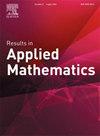一种深度学习方法:用于求解二维非线性正弦戈登方程的物理信息神经网络
IF 1.4
Q2 MATHEMATICS, APPLIED
引用次数: 0
摘要
在目前的工作中,我们应用物理信息神经网络(pinn),一种机器学习方法,来解决二维空间的非线性双曲正弦戈登问题。为了将PDE的所有物理信息包含到学习过程中,我们考虑了一个考虑问题PDE残差、初始条件残差和边界条件残差的多目标损失函数。该问题是使用使用各种人工神经网络拓扑的pin来逼近的,其中一种是前馈深度神经网络,一种密集连接的网络。为了确定所建议的技术的有效性,合理性和实际意义,我们提供了三个非线性二维正弦戈登方程的计算实例。我们训练了PINNs模型,并使用Python软件作为计算工具运行了各种测试。我们给出了该方法在近似NLSGE时的理论误差范围。我们通过均方根误差(RMSE)、L∞和L2相对误差将模型与文献中其他标准数值方法进行比较,从而评估模型的准确性。研究结果表明,所提出的PINN方法比其他数值方法更有效和准确。该方法可以直接应用于涉及不同边界条件的任何问题,而不需要线性化,摄动或插值技术。因此,为了解决二维非线性双曲正弦-戈登方程和其他跨多个领域的非线性物理难题,PINN模型提供了一种既准确又高效的编程机器学习技术。本文章由计算机程序翻译,如有差异,请以英文原文为准。
A deep learning approach: Physics-informed neural networks for solving the 2D nonlinear Sine–Gordon equation
In the current work, we apply a physics-informed neural networks (PINNs), a machine learning approach, for solving the non-linear hyperbolic sine–Gordon problem with two space dimensions. To include all the physical information of a PDE in to the learning process, we considered a multi-objective loss function that takes into account the problem PDE residual, the initial condition residual, and the boundary condition residual. The problem was approximated using PINNs employing a variety of artificial neural network topologies, one of which being feedforward deep neural networks, a densely connected network. To establish the effectiveness, soundness, and practical implications of the suggested technique, we provide three computational illustrations from the nonlinear two-dimensional sine–Gordon equations. We trained the PINNs model and run various tests using Python software as a computational tool. We gave the theoretical error bounds of the proposed approach in approximating the NLSGE. We evaluated the accuracy of the model by comparing it to other standard numerical methods in the literature through root mean square error (RMSE), , and relative errors. The findings suggested that the offered PINN approach is more effective and accurate than the other numerical methods. The method can be directly applied to any problem that involves different boundary conditions without requiring linearization, perturbation, or interpolation techniques. Thus, for the purpose of solving the nonlinear hyperbolic sine–Gordon equation in two dimensions and other difficult nonlinear physical issues across several fields, the PINN model provides an appropriate programming machine learning technique that is both accurate and efficient.
求助全文
通过发布文献求助,成功后即可免费获取论文全文。
去求助
来源期刊

Results in Applied Mathematics
Mathematics-Applied Mathematics
CiteScore
3.20
自引率
10.00%
发文量
50
审稿时长
23 days
 求助内容:
求助内容: 应助结果提醒方式:
应助结果提醒方式:


